Events
Microsoft 365 Community Conference
May 6, 2 PM - May 9, 12 AM
Skill up for the era of AI at the ultimate community-led Microsoft 365 event, May 6-8 in Las Vegas.
Learn moreThis browser is no longer supported.
Upgrade to Microsoft Edge to take advantage of the latest features, security updates, and technical support.
The Microsoft 365 Backup service, offered through the Microsoft 365 admin center, is a pay-as-you-go consumption-based service. The list price is $0.15/GB/month of protected content.
Microsoft 365 Backup charges you based on the size of the following content once it's added to backup protection. That size is the result of the summation of the following two categories:
Summation of the user-facing size of the protected content:
Size of OneDrive accounts and SharePoint sites as displayed in the live sites’ usage reports, which includes the first-stage recycle bin. If a site or OneDrive account is removed from the protection policy, the size of the site at the time it's removed from the policy will be used as the proxy for the site’s "live" size. In other words, your backup costs will never increase once the OneDrive account or site has been removed from the protection policy.
Size of the live user or shared mailbox plus their associated online archives if those are being used. If the mailbox is removed from the protection policy, the size of the mailbox at the time it’s removed will be used as the ongoing proxy for its "live" size until all restore points expire from the backup. In other words, your backup costs will never increase once the mailbox has been removed from the protection policy.
Summation of the deleted and versioned data held for recovery in the backups:
Deleted content in SharePoint sites’ and OneDrive accounts’ second-stage recycle bin (also known as site collection recycle bin).
Deleted and versioned items in the protected mailboxes.
For example, if you protect a 1-GB site that has 0.5 GB of data in its second-stage recycle bin, and a 1-GB mailbox that has a 1-GB online archive, then you'll be charged for 3.5 GB of Microsoft 365 Backup usage.
The restore point frequency doesn't materially impact the cost of the backup storage, so reducing that frequency wouldn't change your costs.
Although Azure is being used as a payment processor, there are no additional Azure API or storage costs beyond the Microsoft 365 Backup usage charges previously mentioned.
Deleted or versioned content held in the recycle bin or in the mailboxes will expire from the backups once the backup retention period lapses (for example, 365 days after the backup is taken). Once deleted or versioned content expires from the backups, they're no longer counted in the backup consumption equation and therefore no longer contribute to the cost. For example, if you have a site under protection that is currently 1 GB for the first month, you're charged for 1 GB of Microsoft 365 Backup usage. If you delete content in that site such that it's now only 0.5 GB, your next monthly bill will still be for 1 GB since the backup tool is retaining that deleted content for a year. After a year when the backup of that deleted content expires, the 0.5 GB being retained for backup purposes will no longer be charged for backup.
If you're using a partner (ISV) solution built on the Microsoft 365 Backup Storage platform, you'll be charged solely by them for their application. You won't receive a separate bill or charge directly from Microsoft for the Backup Storage consumption.
The Microsoft 365 Backup pricing calculator is a tool that helps you estimate the amount of backup storage and the costs that you incur to protect and back up your Microsoft 365 data.
Note
The tool isn't intended to provide an exact prediction of your backup consumption, but rather to give you an estimate.
To use the Microsoft 365 Backup pricing calculator, you need to perform the following steps. Information about how to collect data from each of these steps is detailed later in this article.
Download the latest version of the Microsoft 365 Backup pricing calculator tool (an Excel spreadsheet).
Open the Excel spreadsheet. This sheet produces a simple model for cost calculations.
Gather the information needed in the orange cells on the High-Level Estimates worksheet.
The Total Storage (GB) input field should include the sum of sizes of live data and sizes of recycle bins and mailbox online archives in your tenant. You can get the live data plus the archives and recycle bin deleted content sizes using either PowerShell commands or the Microsoft 365 usage reports. For more information about how to get this data, see Finding the sizes of stored data later in this article.
The Percentage Storage to protect input field should represent the percentage of your content you plan to protect in the Backup tool. You're only charged for what you protect in the tool.
Once you have this information, enter it into the High-Level Estimates worksheet as shown in the following example.

An estimate of the Microsoft 365 Backup costs for 1 month and 12 months will then be generated.
Note
The 12-month cumulative cost assumes no data growth or churn. Understanding your data's growth and churn is a more complex exercise, but can be estimated by looking at your primary storage growth trends in the Microsoft 365 admin center reports and the size of your second-stage recycle bin (which is a general heuristic for the amount of data your tenant churns over a three-month period of time).
Sizes of live data, and deleted data for your SharePoint sites, OneDrive accounts, and Exchange mailboxes can be calculated using two different methods:
PowerShell is the most powerful option because you can get the second-stage recycle bin sizes for SharePoint and OneDrive, and the online archive sizes for Exchange Online. The admin center provides better growth visualization, but doesn't include the second-stage recycle bin or online archive sizes, and is thus incomplete.
You can get the sizes of live sites and first-stage recycle bin in the tenant (one site at a time) by running the following PowerShell cmdlet:
Get-SPOSite
Learn more about the Get-SPOSite cmdlet - Get-SPOSite cmdlet and the SharePoint Online Management Shell.
You can get the sizes of the second-stage recycle bin by running the following PowerShell cmdlet:
Get-PnPRecycleBinItem -SecondStage
Learn more about PnP PowerShell.
You can estimate size of online archives by running the following Exchange Online PowerShell command:
Get-MailboxStatistics -Identity "user@example.com" -Archive | Select DisplayName, TotalItemSize, ItemCount
For live mailbox sizes, use the Microsoft 365 admin center usage reports.
This section describes how to use your Microsoft 365 admin center usage reports to populate the Microsoft 365 Backup pricing calculator. Note that content in the OneDrive and SharePoint second-stage recycle bins and data in a mailbox's online archives won't be reflected in these reports, and need to be calculated separately.
To get information on current usage, go to Usage - Microsoft 365 admin center and then review the OneDrive - Usage, SharePoint - Site usage, or Exchange - Mailbox usage reports.
You can change the period that the reports display data for by selecting the Past n days on the right-hand side and then selecting the period. That option provides you with a historical view over that period of the size of your live data, and thus gives you a hint about how quickly your live data tends to grow, if you choose to extrapolate those graphs into the future.
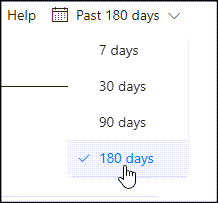

Amount of storage used at the start of at the start of the period and at the end of the period. For example, 0.58 GB and 0.37 GB:

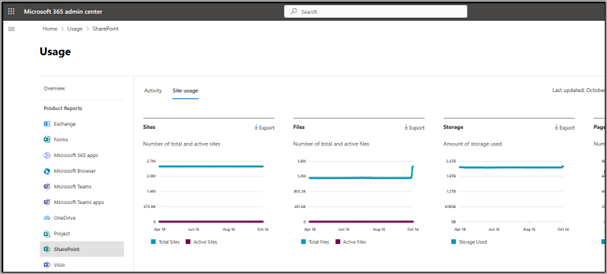
Amount of storage used at the start of at the start of the period and at the end of the period. For example, 2,200 GB and 2,200 GB:
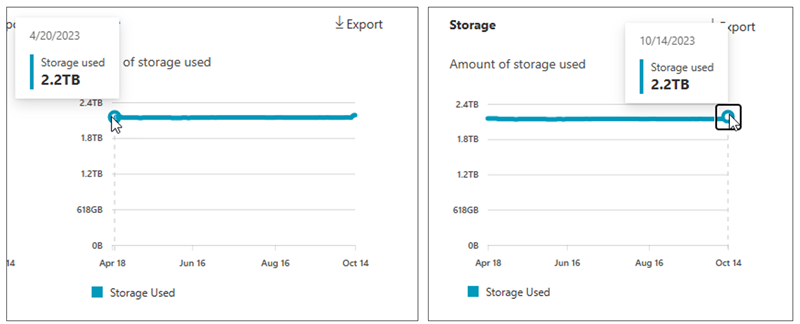
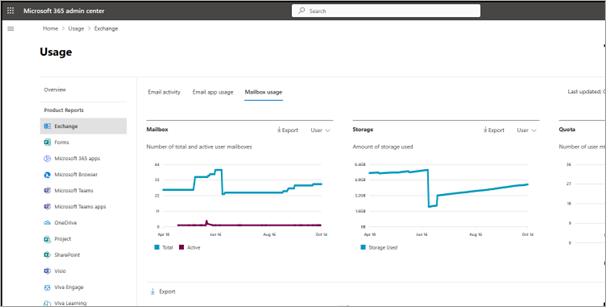
Amount of storage used at the start of the period and at the end of the period. For example, 5.5 GB and 4.3 GB:
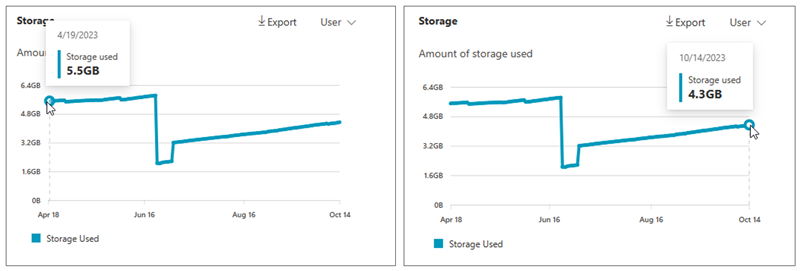
When using the Microsoft 365 Backup pricing calculator, be aware of the following points:
Any cell that is colored orange can have data entered.
To modify how much storage you want to protect per service type, you can change the Percentage of Storage to protect. For example, if you only want to protect 20 percent of your SharePoint storage, you can set the Percentage of Storage to protect for SharePoint to 20%.
The Price per GB field can be modified if necessary. For the Microsoft 365 Backup solution, we recommend that you use the default value.
Events
Microsoft 365 Community Conference
May 6, 2 PM - May 9, 12 AM
Skill up for the era of AI at the ultimate community-led Microsoft 365 event, May 6-8 in Las Vegas.
Learn moreTraining
Module
Describe Microsoft 365 pricing, licensing, and billing options - Training
Learn about the pricing models for Microsoft cloud services and how Microsoft 365 is available through various licensing and billing options to meet the needs of people and organizations.
Certification
Microsoft Certified: Information Protection and Compliance Administrator Associate - Certifications
Demonstrate the fundamentals of data security, lifecycle management, information security, and compliance to protect a Microsoft 365 deployment.
Documentation
Learn how to turn on Microsoft 365 Backup, set up pay-as-you-go billing, and create backup policies for OneDrive, SharePoint, and Exchange.
Overview of Microsoft 365 Backup
Learn about the backup and recovery capabilities for OneDrive, SharePoint, and Exchange Online using Microsoft 365 Backup.
Manage consumption and invoices for Microsoft 365 Backup
Learn how to set up and manage usage and invoices in the Azure portal for Microsoft 365 Backup.